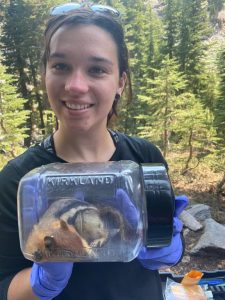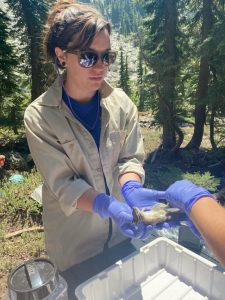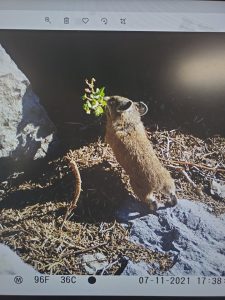A day in the life: Lassen Volcanic National Park

Mornings are cool, quiet, beautiful….and wayyy to early. Alas, this is the biologists conundrum. The small mammals rise early, and so do we (at least I’m not an ornithologist). We set out for the day to check the Sherman traps we set the night before. Mice, mice, mice, and oh something else? Wait…no that’s just a mouse. Don’t get me wrong, mice are very cute (and important to our project), but could we catch something else pleaseee? We open up the traps for the day, now opening the Tomahawks hoping to catch the ever so elusive Pika! Most of the time we just catch chipmunks and golden mantled ground squirrels, which are an important piece of the puzzle too!
The Pika and Plague Project

You may be asking, why are we trying to catch these cute little critters? Well hold on to your seats, because this is a rough ride. The American Pika has been petitioned to be on the endangered species list several times – which is a long, complicated, drawn out process. The Pika are very sensitive to changes in temperature, thus climate change has been a major concern for these little guys. Pika tend to live in areas around 8,000 feet in elevation, where it generally stays cooler. With rising temperatures, they must shift their territories upward to maintain the cool temperature of the alpine environment. As we all know, mountains have a peak…so they can only shift so far. Their body temperature float around 104 degrees F, which is warmer than most mammals. This means if ambient temperatures get to high (not even that high, like 77 degrees F) then they can overheat, and die. Yeah, crazy, I know. And if that wasn’t bad enough – they are also threatened by the plague. The plague is caused by a bacterium (Yersina pestis) which is transmitted by fleas. The hypothesis is other small mammals that live is close association with Pika are transmitting the plague by bringing fleas to their nesting areas. Hence why we are interested in capturing mice, wood rats, chipmunks, and squirrels as well.
It isn’t all bad news
Phew, I know that was a lot to dump on you, so here’s the good news: Science is amazing! A vaccine for the plague has been developed, and injecting animals with said vaccine is part of our process! I wont bore you with the details, but basically the vaccine contains a protein that encapsulates the bacterium, and helps the body initiate an immune response to fight off the disease. So there is hope! The vaccine has been shown to be successful in other habitats and species such as the Black-footed ferret and prairie dogs. Use of the vaccine on Pika is still pretty new, so I guess you could say this is ground breaking research *wink wink*.
Alright alright, I’ll give you all what you’ve been waiting for: PIKA PICTURES!!!!!!!

Disclaimer: All animals were handled by trained professionals
https://www.arcgis.com/apps/Cascade/index.html?appid=d0181b2625e24a86b5c159919254b230

